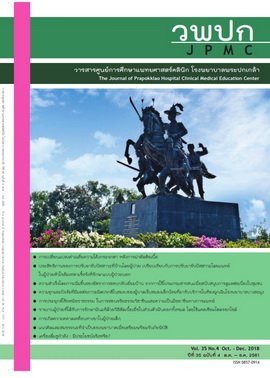แนวคิดและสมรรถนะที่จำเป็นของพยาบาลเพื่อเตรียมพร้อมรับภัยพิบัติ
Main Article Content
บทคัดย่อ
ปัจจุบันปัญหาภัยพิบัติมีแนวโน้มเพิ่มสูงขึ้น และทวีความรุนแรงเพิ่มขึ้นเรื่อยๆ นำมาซึ่งความสูญเสียทั้งต่อชีวิตและทรัพย์สินอย่างมหาศาล ปัญหาภัยพิบัตินับเป็นปัญหาสากลที่ทุกประเทศต้องเตรียมความพร้อมรับกับความเสี่ยง พยาบาลเป็นหนึ่งในบุคลากรทีมสุขภาพที่มีบทบาทสำคัญในการช่วยเหลือในสถานการณ์ภัยพิบัติในระยะต่างๆ ของการเกิดภาวะภัยพิบัติ การเตรียมความพร้อมให้พยาบาลมีสมรรถนะที่เหมาะสมจึงมีความสำคัญยิ่ง สภาการพยาบาลสากล (international council of nurses: ICN) ได้พัฒนากรอบสมรรถนะด้านการพยาบาลภัยพิบัติ 4 ด้าน ได้แก่ ระยะป้องกันและบรรเทาผลกระทบจากภัยพิบัติ ระยะการเตรียมพร้อมรับภัยพิบัติ ระยะการรับมือภัยพิบัติ และระยะการพักฟื้น/ฟื้นฟูสภาพของบุคคล ครอบครัวและชุมชน ดังนั้นพยาบาลจึงควรได้รับการส่งเสริมเตรียมความพร้อมให้มีสมรรถนะด้านการพยาบาลในภาวะภัยพิบัติ เพื่อให้สามารถปฏิบัติการพยาบาลที่เป็นมาตรฐานทั้งในระดับชาติและนานาชาติ
บทความวิชาการนี้นำเสนอแนวคิดและสมรรถนะที่จำเป็นสำหรับพยาบาลในภาวะภัยพิบัติ เพื่อที่จะสามารถใช้เป็นแนวทางการจัดการภาวะภัยพิบัติ และสามารถนำไปพัฒนาสมรรถนะบุคลากรทางการพยาบาลให้มีทักษะในการจัดการภาวะภัยพิบัติอย่างมีประสิทธิภาพต่อไป
Article Details
References
1. Department of Disaster Prevention and Mitigation, Ministry of Interior. Reduce disaster risk. Bangkok: Agricultural Cooperative Federation of Thailand; 2013.
2. Department of Mineral Resources. Tsunami [Internet].2005 [cited 2018 Jun 20]. Available from:https://www.dmr.go.th/download/tsunami_manual/005.pdf.
3. Siripul P, Sakdisthanont S. Disaster nursing: essential competencies for Thai nurses. Thai Journal of Nursing Council 2012; 27(Special Issue): 18-30.
4. ProVention Consortium. Hyogo framework for action [Internet]. 2007 [cited 2018 Jun 20]. Available from: https://www.unisdr.org/files/1217_HFAbrochureEnglish.pdf
5. The Nurses’ Association of Thailand. ICN framework of disaster nursing competencies. Bangkok: The Nurses’ Association of Thailand; 2014.
6. Cox E, Briggs S. Disaster nursing: new frontiers for critical care. Criti Care Nurse 2004; 24:16-22.
7. World Health Organization. Risk reduction emergency preparedness [Internet]. 2007 [cited 2018 Jun 10]. Available from: https://www.who.int/hac/techguidance/preparedness/emergency_preparedness_eng.pdf.
8. International Federation of Red Cross and Red Crescent Societies. Introduction to disaster preparedness [Internet]. 2000 [cited 2018 May 20]. Available from: https://www.ifrc.org/Global/Introdp.pdf.
9. International Council of Nurses. ICN creates disaster network. Int Nurs Rev 2007; 54: 213-5.
10. World Health Organization and International Council of Nurses. ICN framework of disaster
nursing competencies. Geneva: WHO/WPRO [Internet]. 2009 [cited 2018 May 10]. Available
from: https://www.wpro.who.int/hrh/documents/icn_framework.pdf
11. Gebbie KM, Qureshi K. Emergency and disaster preparedness: core competencies for nurses.
Am J Nurs 2002;102:46-51.
12. Lukthitikul S, Hatthakit U, Perawutt J. Experiences of nurses practising during the tsunami at hospitals of Phang-Nga province. Songkla Med J 2008; 26:349-60.
13. Chuengsatiansup K, Singha S, Netiparatanakul P, Suputtamongkol S. Community disaster
tools. Nonthaburi: Suksala Books; 2014.
